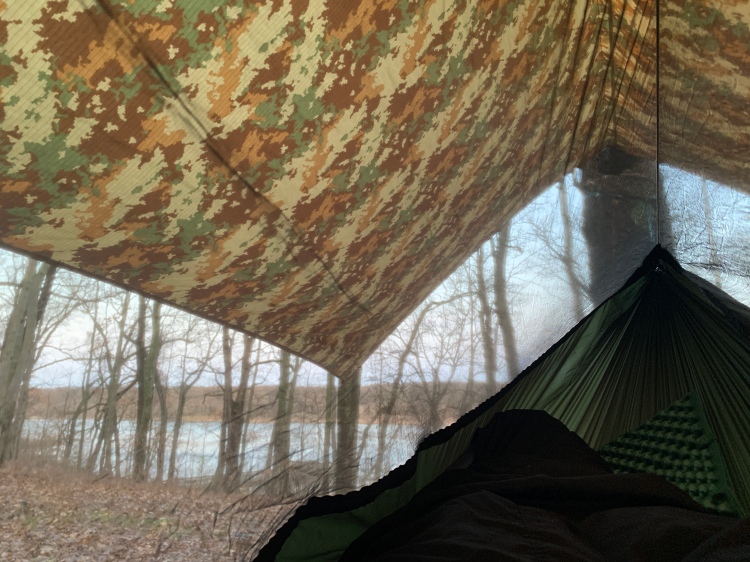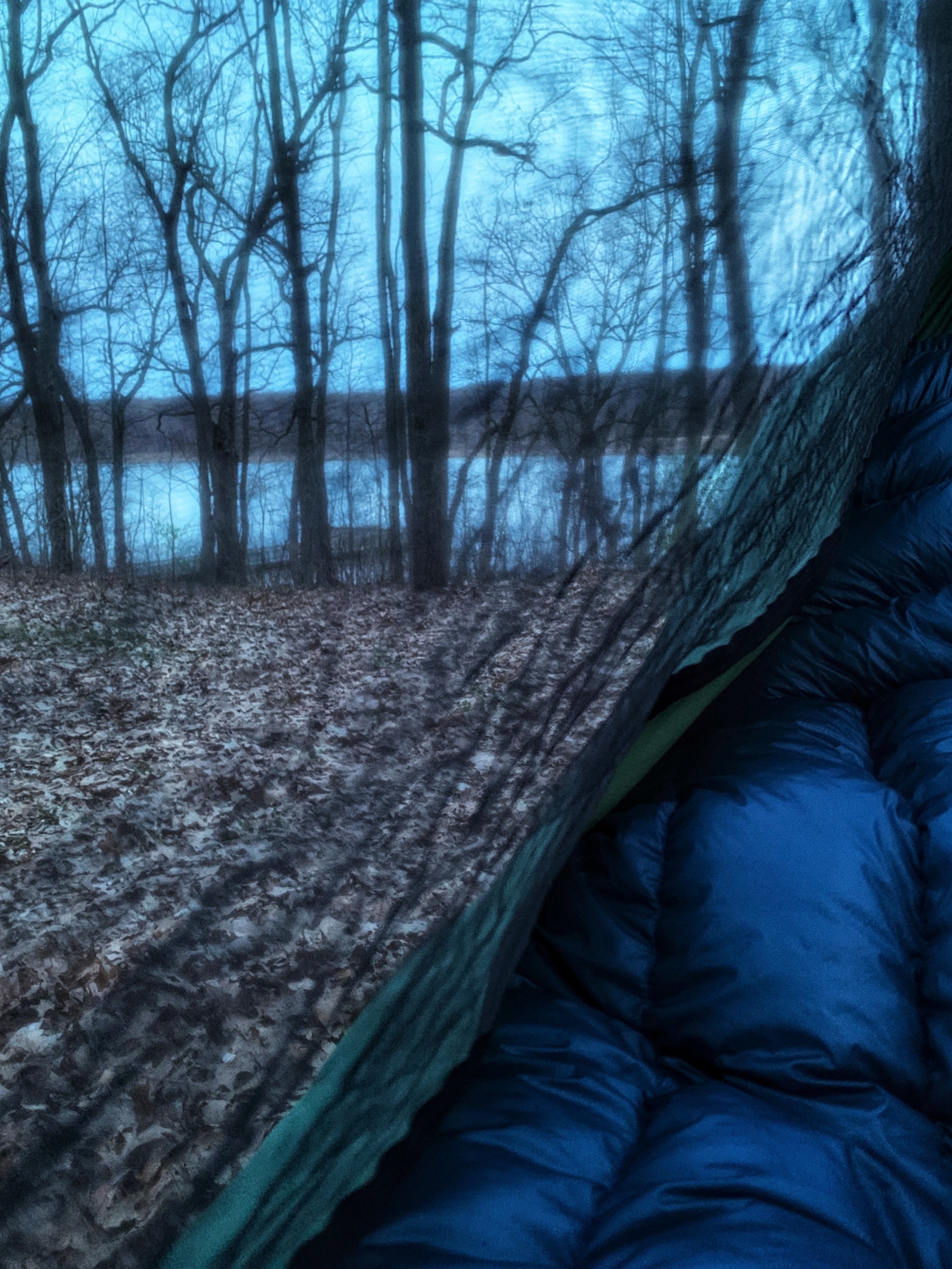I recently planned a group trip as a “get to know each other” event for the hiking and backpacking Facebook page I facilitate. We used an organizational campsite at Yankee Springs Recreation Area’s Deep Lake campground. About 30 people had signed up, and several expert group members had volunteered to give presentations on various aspects of backpacking. With the migrating birds and gradually greening forests, it looked to be a good weekend.

And then the forecast came out, predicting rain all day Friday, with a chance of thunderstorms overnight. Not ideal, to say the least. While I encouraged attendees to arrive Saturday morning if that was more in their comfort zone, I figured some die-hards would tough it out through the rain, and since the campsite reservation was in my name, I felt obligated to be with them. When school got out Friday, it was lightly misting as I got into my car and headed for Yankee Springs. Over the hour and a half drive, I experienced everything from mist to driving rain.
Luckily, it was just drizzling as I set up a big tarp for community space, and then set up the tarp for my hammock. A friend arrived in a newly tricked-out camper van, offered me a dry bed for the night, and I faced the age-old question of whether to throw in the towel or tough it out.
I had brought my hammock, an Eno Pro-Fly tarp, and rather than my down underquilt, a Thermarest Z-lite foam pad for insulation. My gear choice with the pad was two-fold: With the rain in the forecast, I was afraid my underquilt would get damp, and I also wanted to try a “dual purpose” set up, as I’m headed out for a section hike on the Appalachian Trail this fall, and would like to be able to sleep in my hammock some nights and in shelters on others, and would like to streamline gear, rather than carrying both an underquilt for hammock nights and a pad for shelter nights. If the pad could do double-duty, it will be what comes with me on the AT.
I waited until right before bedtime to put my down top quilt into the hammock–I didn’t want it soaking up any extra moisture from the damp air. I figured if things went too badly, I’d just sleep in my car.
Around 10:00 p.m., the group that had gathered under a canopy to meet and catch up dispersed to bed, and I tried as best I could under my small hammock tarp to remove wet clothing, change into dry, and pop into bed, without the insulator pad slipping out from under me, which is easier said than done. I moved my hiking boots so they were directly under my hammock, hoping to protect their interior from any errant spray from the rain. I snuggled into my down top quilt, watched the reflection of the sky on Deep Lake, and fell into a light sleep, interrupted every so often by a shift in the wind’s intensity, or the rain pattern.
After an hour or so, I began to hear rumblings of thunder, and I considered my circumstances. I was camped next to my car, which was likely much safer from lightning-strike than anything else, but because the forest was pretty dense, medium in terms of elevation, I was not hanging from particularly tall trees, and was lying on an insulated mat, I felt relatively safe. I had checked the area around me for dead trees and widow-maker branches before setting up, so I decided to ride it out in my hammock, and see how it went. As the rain and wind picked up, I could see a light mist in the air, and I wondered if my top quilt would get damp, and then cold. Lightning lit up the sky periodically, and noise from thunder and wind made sleeping unrealistic. I considered putting in earbuds and listening to a podcast, but decided to just keep listening to the storm.
Around 1:30 a.m. it finally abated. The wind continued to blow, and I welcomed it as a drying force for my wet tarp. Finally, deep sleep came.

I awoke to the sounds of Canada geese honking, blackbirds trilling, and sandhill cranes making that strange warbling cackle that makes me think they might be pterodactyls. The sun was just coming up, the sky was a clear blue, and last night’s rain was long gone. I ran my hands over my top quilt, expecting it to feel damp, but it was not. I looked through my bug netting down onto the ground and saw a distinct drip line where the rain had drained off of my tarp. The sand and dirt underneath the tarp were dry, with a straight line of demarcation at the drip line. I unzipped the bug net and reached for my boots, holding one up for inspection before easing it onto my foot. It, too, was bone dry. I gave the tarp a shake to fling off any remaining rain water, but it seemed to have dried in the wind. I exited the hammock and inspected my gear outside of the tarp–my tree straps were wet, but the rainwater had dripped down the bitter end of my Becket Hitch knots that attached them to the Amsteel continuous loops at the ends of my hammock, so the hammock was dry even at the ends. Even though the tarp was only about an inch longer than my hammock at either end, it had kept the hammock completely dry.
I left the situation feeling much more confident in this gear set up. While the Thermarest pad wasn’t nearly as cozy as my underquilt, it had kept me insulated from the dreaded “cold hammock butt” that is common when lying in a hammock without any under-insulation, and I didn’t have a damp underquilt to deal with. I do have to test out whether or not I can sleep comfortably on a hard shelter floor with this pad. It’s been years since I’ve used it on the ground, whether a tent or shelter.
I hadn’t trusted the tarp to keep me completely dry, but it had done much better than I expected, although I think that was in part due to the wind coming at me from a 90-degree angle, so it was hitting the tarp broadside. I do have a bigger tarp that I often bring when rain is in the forecast, but it is so big that it can be tricky to find trees spaced properly to hang it from. I was glad to find that this smaller tarp offered good protection.
It can be so tempting to just opt for what’s easy. I’m sure if I’d accepted my friend’s offer to sleep in her van, I would have had a much better night’s sleep. Because I didn’t, I am much more confident that if I got caught in bad weather on a multi-day trip with no bail out options, my gear would be sufficient to keep me safe and reasonably comfortable.
It might seem strange to suggest, “It’s freezing outside–I’m going to see how warm my sleeping bag keeps me,” or “It’s pouring–let’s see what it’s like to set up a tent in this,” but those are things that we should really all do, if we’re planning on camping without bail out options.

I thoroughly enjoy reading your posts, Jennifer. Always descriptive, informative and colorful! I, too, have been dreaming of section hiking on the Appalachian trail. See you soon!
LikeLike